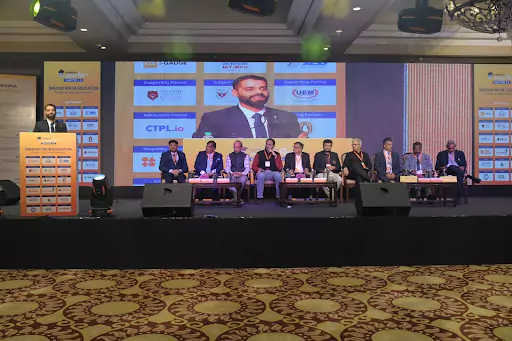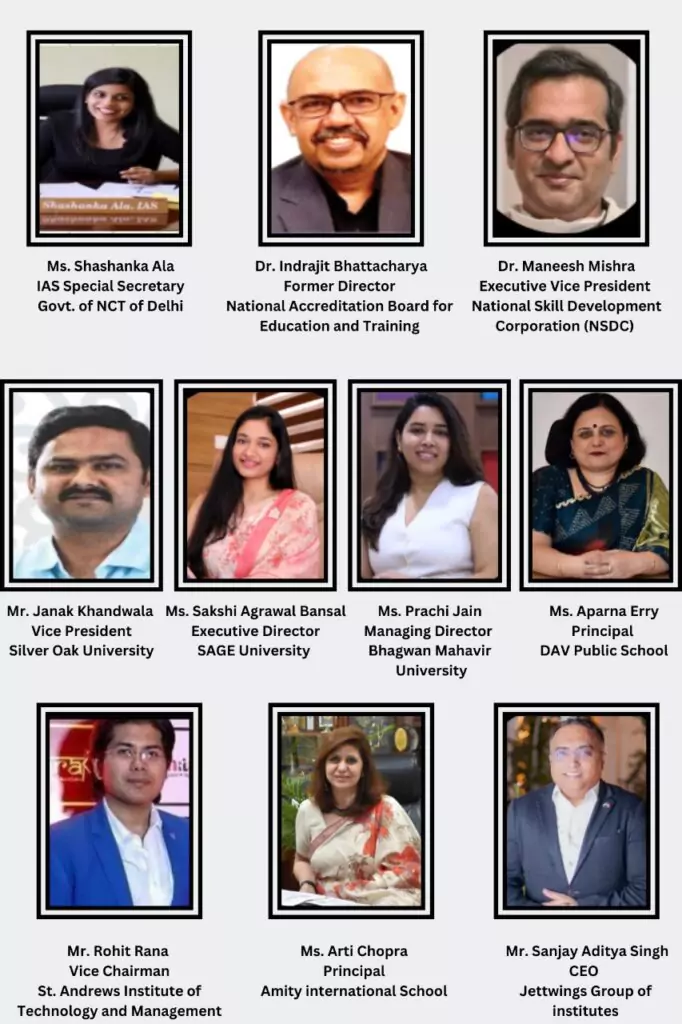This article investigates the Digital Blueprint for Smart Learning, an innovative framework that integrates digital technologies into educational practices for enhanced learning experiences.
The study examines the implementation strategies, impact on students and educators, and challenges associated with the adoption of this digital blueprint.
Through a comprehensive analysis of existing literature, case studies, and empirical evidence, the paper provides insights into the transformative potential of smart learning technologies.
| Civic Engagement for the Smart Age | A Learning Lifestyle | Systemic Interdependence | Smart Technologies for All | Many Selves, Many Stories |
- Civic Engagement for the Smart Age – Education institutions can enhance democratic participation by empowering learners of all ages and backgrounds to express their visions, thereby revitalizing a proactive citizenry and shaping a society that reflects everyone’s aspirations.
- A Learning Lifestyle – The emphasis is on the potential of integrating learning into communities, thereby enhancing students’ experiences and laying a solid foundation for future success.
- Systemic Interdependence – The initiative encourages partnerships between schools, districts, and other education organizations to enhance support and organizational resilience, fostering collaboration across traditional boundaries to identify innovative solutions for young people’s well-being.
- Smart Technologies for All – The emphasis is on the need for education leaders to understand the potential benefits and risks of AI and neuro-enhancement tools in education, develop digital literacy, and establish ethical frameworks.
Many Selves, Many Stories – The study explores how integrating students’ experiences and identities into their learning can enhance engagement, improve outcomes, and empower them to create purposeful learning paths.


Collegedunia , being one of the leading organizations in the field of education, organizes a B2B Education Summit , “Collegedunia Connect” every year. Leading personalities of the industry are invited for a whole day event packed with discussions, whitepaper launch and Award ceremony.
In Collegedunia Connect 3.0 “Smart Learning” was one of the discussion topics amongst many others.
Our honorable panel discussion members :-

What kind of smart learning is currently happening?
With Kerala being the first Indian state to have high tech classrooms in all public schools , India is all set to transform learning completely across the country.
“AI can be used to analyze student data and determine their strengths and limitations. This data can then be utilized to build personalized learning programmes that are suited to each student’s unique needs.”
Dr. Indrajit Bhatacharya added AI will bless our society with more flexibility, engagement, better feedback, and faster communication, making the learning process more adaptive and anxiety free. He also mentioned Predictive learning and Technology-Enabled Subjective Assessment (TESA).
Now, what is TESA ? Technology-Enabled Subjective Assessment (TESA) blends traditional subjective evaluation with advanced technology. It uses AI and multimedia techniques to deliver a comprehensive and objective assessment of subjective criteria, resulting in a more complete picture of individual performance.
Dr.Maneesh Mishra added how personalized and adaptive learning is based on individual needs and progress.
What is Personalized Learning? What is Adaptive Learning?
Personalized Learning puts the learner in the driver’s seat. It’s about tailoring the educational experience to individual preferences, goals, and learning styles. Whether you’re seeking to delve deeper into a specific topic or prefer a flexible learning pace, personalized learning provides the autonomy to choose your path.
Adaptive Learning takes personalization a step further by dynamically adjusting the learning path based on individual performance and understanding. It’s like having a personal tutor who tailors the content to your strengths and areas that need improvement, ensuring a challenging yet manageable learning experience.
What kind of initiatives is the government taking ?
Education is on the concurrent list of the Constitution, and the bulk of schools are under the jurisdiction of the different state and UT governments. However, in order to ensure that every student, especially those living in rural and educationally backward parts of the country, continues to have access to education, the Ministry of Education’s Department of School Education and Literacy has implemented a multi-pronged approach.
On May 17, 2020, a comprehensive project named PM e-Vidya was launched as part of the Atma Nirbhar Bharat Abhiyan to unify all initiatives connected to digital/online/on-air education and offer multi-mode access to education.
Ms Shashanka Ala emphasized on the need for funding to private universities by the government.
Why Government Funding is Crucial ?
- Equitable Access to Quality Education:
Government funding ensures that quality education is not limited to economic circumstances. It opens doors for students from various backgrounds, promoting inclusivity and diversity within the academic sphere.
- Research and Innovation:
Adequate funding enables private universities to invest in cutting-edge research and innovation. This, in turn, contributes to the nation’s progress by fostering advancements in various fields.
- Global Competitiveness:
Well-funded private universities can attract top-tier faculty, create state-of-the-art facilities, and establish collaborations with international institutions. This enhances the global competitiveness of our education system.
Dr. Aman Mittal shared LPU’s initiative with the Learning Management System (LMS) .
LPU is dedicated to using technology on campus to ensure seamless operation. Almost ninety percent of the jobs that are completed at the university include some form of high-end technology these days. At LPU, all academic and administrative responsibilities are managed via their very own UMS (University Management System), an innovative, award-winning web-based internal solution that exposes students to a wide range of resources with just a click. In the same vein, university staff and students have access to resources like LMS, MYCLASS, ECONNECT, OAS (Online Assessment System), OMS (online management system), etc.
However, it’s important to address a notable disparity in enrollment numbers. There exists a gender gap in the enrollment of female students compared to male students who come to India for education. Efforts to promote gender inclusivity in international student enrollment are an essential component of India’s commitment to diversity and accessibility in higher education.
Nonetheless, according to data from Collegedunia, there appears to be a decrease in the gap in the year 2023.
Technology Infrastructure
A collection of information technology components, usually physical but also include other software and network components, that constitute the basis of an IT service is referred to as information technology infrastructure.
Are we able to use the current technology efficiently?
Mr. Janak Khandwala Expanded on the idea that digital technology should not be restricted to education only. He highlighted the role of technology in breaking the limitations of physical classrooms and emphasized the importance of utilizing technology to improve student performance and refining strategies.
Technology is essential to education because it gives students future-ready skills. By offering individualized experiences that accommodate different requirements and learning preferences, it improves accessibility and diversity through virtual classrooms and online learning environments. By guaranteeing equitable access to technology and the internet, the technology empowers underprivileged communities and tackles the issue of the digital divide. Blended learning strategies offer flexibility and customisation by integrating virtual and real components. Learning becomes dynamic and engaging with the use of gamification and interactive tools. Learning analytics are used in data-driven education to provide individualized training and track student development. Through the development of future-ready abilities like digital literacy, teamwork, and communication, technology helps students get equipped for the needs of the labor market.
Are you collaborating with edtechs in any way? If yes, how are you able to take advantage of the technology they are building?
Mr. Rohit Rana positively emphasized the benefits of collaborations with edtech platforms,discussing the exposure students gain by collaborating with teachers and professors and mentioned student rankings based on platforms created by edtechs and the importance of collaboration with international researchers.
Collaborating with EdTech platforms can offer numerous benefits for students, providing them with valuable exposure and opportunities to enhance their learning experiences. Here are some of the advantages of such collaborations, particularly focusing on the exposure students gain by working closely with teachers and professors through EdTech platforms:
- Global Reach and Diversity
- Access to Expertise
- Real-world Application
- Interactive Learning Environments
- Customized Learning Paths
- Timely Feedback and Support
- Technology Integration
- Networking Opportunities
- Flexibility and Accessibility
Ms. Arti Chopra Outlined three main cornerstones: Workforce, data handling, and technology itself. She advocated for Professional Learning Networks (PLN) as part of the system and emphasized the need for flexible learning, consistent teacher training, and compulsory cybersecurity education for students. She also discussed the importance of personalized learning.
Mrs. Aparna Erry stressed the need to focus on maintenance as it differs over the years. She advocated for proper upkeep and servicing.
Importance of upkeep and servicing
The importance of upkeep and servicing of technology cannot be overstated, as it plays a crucial role in ensuring the optimal performance, longevity, and security of technological assets. Whether it’s personal devices, business infrastructure, or industrial machinery, regular maintenance and servicing offer several key benefits:
- Enhanced Performance
- Extended Lifespan
- Cost Savings
- Security and Reliability
- Optimized Energy Efficiency
- Compliance with Regulations
- Minimized Downtime
- Improved User Experience
- Adaptation to Changing Needs
- Preservation of Data Integrity
Mrs. Aparna Erry Acknowledged ongoing tech changes and educator training initiatives. Emphasized the need for a top-down approach for technology acceptance.Teachers are taking initiatives with AR, VR, and AI.Differentiated between teacher-centered and student-centered approaches, emphasizing empathy.
Differences between these two approaches with a specific focus on empathy:
- Teacher-Centered Approach:
Focus: The primary focus is on the teacher, who is the central figure responsible for imparting knowledge and controlling the learning process.
Role of the Teacher: The teacher plays a more authoritative role, delivering lectures, directing class activities, and dictating the pace and content of learning.
Emphasis on Empathy: In a teacher-centered approach, empathy may be limited. The teacher might not always be attuned to individual student needs, as the emphasis is often on delivering curriculum content efficiently.
- Student-Centered Approach:
Focus: The primary focus shifts to the students, who actively participate in their own learning and play a more significant role in the educational process.
Role of the Teacher: The teacher becomes a facilitator, guiding and supporting students in their learning journeys. The emphasis is on creating an environment that fosters independent thinking and exploration.
Emphasis on Empathy: Empathy is a core element of student-centered approaches. Teachers actively seek to understand the unique needs, backgrounds, and learning styles of individual students. This understanding allows for more personalized support and a deeper connection between the teacher and students.
Ms. Prachi Jain highlighted that education is not ahead of other industries in gathering data insights. She suggested that the government should focus on data insights, similar to the financial sector and discussed new trends and innovations such as AR, VR, AI, 5G, robotics, etc.
Smart learning, also known as technology-enhanced learning, faces various challenges that need careful consideration and mitigation strategies to ensure its effective implementation. Here are some challenges and corresponding mitigation strategies:
Access and Connectivity:
-
- Challenge: Unequal access to technology and the internet can limit the implementation of smart learning, especially in underserved or remote areas.
- Mitigation: Providing affordable devices, internet connectivity solutions, and establishing community learning centers can help bridge the digital divide.
Digital Literacy:
-
- Challenge: Insufficient digital literacy among students and educators may hinder the effective use of smart learning tools.
- Mitigation: Implementing training programs for educators and students to enhance digital literacy, including navigating online platforms, using productivity tools, and critically evaluating digital content.
Cost and Infrastructure:
-
- Challenge: Establishing and maintaining the necessary technological infrastructure can be costly, especially for educational institutions with limited budgets.
- Mitigation: Exploring cost-effective solutions, seeking partnerships with technology providers, and leveraging cloud-based services can help mitigate financial constraints.
Data Privacy and Security:
-
- Challenge: Safeguarding student and institutional data from breaches and unauthorized access is a critical concern.
- Mitigation: Implementing robust cybersecurity measures, complying with data protection regulations, and conducting regular security audits can help mitigate risks and ensure data privacy.
Teacher Training and Support:
-
- Challenge: Many educators may lack the necessary skills and training to effectively integrate smart learning technologies into their teaching methods.
- Mitigation: Offering ongoing professional development opportunities, workshops, and mentorship programs can help educators build the skills needed to leverage technology for enhanced teaching and learning experiences.
Content Quality and Relevance:
-
- Challenge: Ensuring that digital content is of high quality, up-to-date, and aligns with educational objectives can be a challenge.
- Mitigation: Collaborating with content developers, regularly updating digital resources, and involving educators in the content creation process can help maintain the relevance and quality of learning materials.
Student Engagement:
-
- Challenge: Sustaining student engagement in a digital learning environment can be challenging, especially with potential distractions.
- Mitigation: Employing interactive and gamified learning approaches, fostering collaborative activities, and encouraging regular communication can enhance student engagement in smart learning.
Technical Issues and Downtime:
-
- Challenge: Technical glitches, system failures, or downtime can disrupt the learning process.
- Mitigation: Establishing a robust technical support system, implementing redundancy measures, and having contingency plans in place can minimize disruptions and ensure a smoother learning experience.
Inclusive Learning:
-
- Challenge: Ensuring that smart learning is inclusive and caters to diverse learning styles and needs can be challenging.
- Mitigation: Designing flexible learning pathways, incorporating universal design principles, and providing additional support for students with diverse needs can promote inclusivity.
Evaluating Learning Outcomes:
-
- Challenge: Assessing the effectiveness of smart learning in terms of educational outcomes may pose a challenge.
- Mitigation: Implementing continuous assessment strategies, using data analytics to measure student progress, and gathering feedback from both students and educators can aid in evaluating and improving the impact of smart learning.
Addressing these challenges with strategic planning, ongoing support, and a commitment to adapting to evolving technologies can contribute to the successful implementation of smart learning in educational settings.






